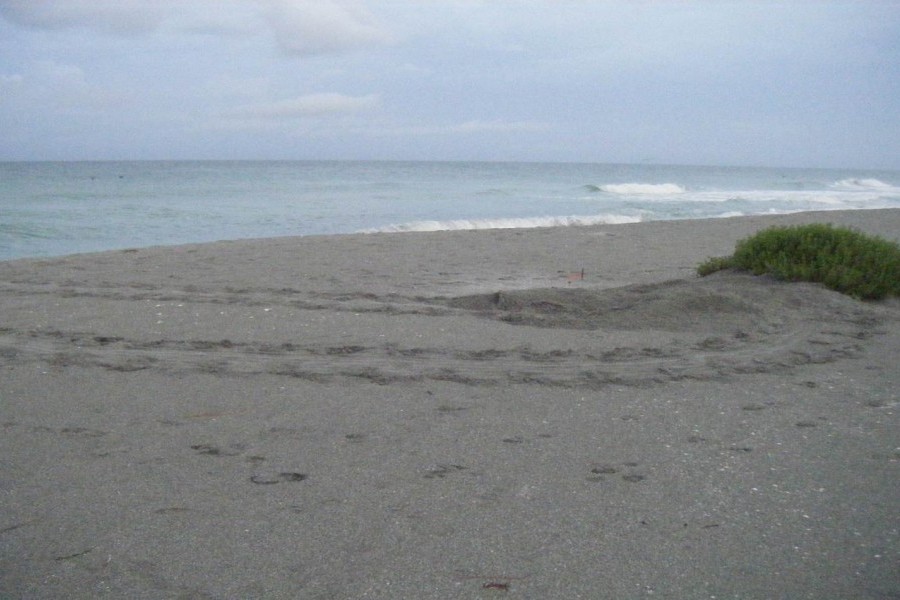Sea turtle nesting season to start May 1
The official season for sea turtle nesting on the Gulf Coast of Florida begins May 1 and ends Oct. 31, but nesting turtles may be here sooner or hatch a little later.
Mote Marine Laboratory, which monitors sea turtle nesting along 35 miles of beaches from Longboat Key through Venice, has a few tips on how to help keep local waters and beaches safe for beach recreation and sea turtle nesting season.
This year, Mote’s Sea Turtle Conservation and Research Program will continue its long-term studies of local sea turtles by documenting every sea turtle nest and false crawl (when a turtle emerges but does not leave a nest) in Mote's patrol area, marking each nest with yellow stakes and flagging tape and collecting scientific data about each nest when it is found. Mote will also collect detailed scientific data on a representative sample of nests through their hatch, allowing researchers to document local trends in nest success as part of the sea turtle conservation and research mission Mote has carried out for more than three decades.
Mote research has shown that nest numbers have increased locally in recent years. Last year, the total number of nests (including loggerhead and greens) along Longboat Key through Venice reached 2,475 nests in 2015, which beats the 2012 record by 6 nests.
Out of those nests, 340 were laid along Longboat Key Manatee County, beating its previous 2013 record of 327 nests; 698 nests were laid along the entirety of Longboat Key, beating its 2013 record of 643 nests; 408 nests were laid along Siesta Key, beating its 1995 record of 343 nests; and a total of 36 green sea turtle nests were laid along the 35 mile stretch of beaches, which broke Mote’s previous record of 30 green turtle nests in 2013.
You may see Mote staff members monitoring sea turtle activity along Longboat Key and South Siesta Key from 6:30 a.m. to 8:30 a.m. before the “official” start date of sea turtle nesting season. This is because eroded stretches of Gulf of Mexico beaches on Longboat Key and South Siesta Key are being nourished (receiving new sand).
This nourishment project requires detailed monitoring for all nests on actively or recently nourished beaches. Thus, Mote scientists started monitoring these areas with active beach nourishment on April 15, two weeks early. In order to adequately monitor the 6-mile stretch of beach in a timely manner, you may see Mote staff members on an ATV rather than monitoring by foot, which is the typical means of beach monitoring. Mote staff uses the ATV to cover large stretches beach, but on most other beaches they patrol by foot.
Sea Turtle Tips for the Public: Boating, Beach Lighting and More
During nesting season, it is important to keep local waters and beaches sea-turtle friendly.
Sea turtles are swimming just offshore to mate before the females come ashore to nest, juvenile turtles are feeding along the Gulf Coast, and by early summer the first hatchlings will venture into Gulf waters.
On the nesting beaches, light from waterfront properties can disorient nesting female turtles and their young, which emerge at night and use dim natural light to find the sea. Also, beach furniture and other beach equipment, toys or trash left on the beach overnight during sea turtle nesting season can pose a serious entanglement hazard and obstacle for sea turtles and their hatchlings.
Temporary structures, including but not limited to beach chairs, umbrellas and cabanas that have the potential for entrapment of marine turtles, should be removed from the beach from sunset to sunrise during each night of sea turtle nesting season, May 1 – Oct. 31.
Beachgoers should also wait until at least sunrise to set up furniture or other equipment. This will allow any new turtle crawls and nests to be documented by Mote scientists. If you see turtle tracks not yet documented by Mote (documented tracks are crossed out with an ‘X’), please avoid placing furniture on them and call Mote's Turtle Patrol at 941-388-4331 to report their location.
Mote encourages coastal residents and visitors to follow the turtle-friendly tips below during nesting season, May 1 - Oct. 31.
On the Shore
Do:
- If you encounter a nesting turtle or hatchlings, remain quiet and observe from a distance.
- Shield or turn off outdoor lights that are visible on the beach from May through October and close drapes after dark.
- Fill in holes and knock down sand castles and stack beach furniture at the dune line or, ideally, remove it from the beach.
- Fill in holes that may entrap hatchlings on their way to the water.
Do Not:
- Approach nesting turtles or hatchlings, make noise, or shine lights at turtles.
- Use flashlights or fishing lamps on the beach.
- Encourage a turtle to move while nesting or pick up hatchlings that have emerged and are heading for the water.
- Use fireworks on the beach.
On the Water
- Follow Coast Guard-approved safe boating guidelines and use vigilance to avoid striking sea turtles and other large marine life.
- Be sure to stow trash and line when under way. Marine debris that accidentally blows overboard or out of a vehicle can become ingested by or entangled around marine life.
- Wear polarized sunglasses to better see marine life in your path.
Emergency Contacts
If you see a sick, injured or stranded sea turtle in Sarasota or Manatee county waters, contact Mote Marine Laboratory’s Stranding Investigations Program at 888-345-2335. Outside of Sarasota or Manatee counties, please call the Florida Fish and Wildlife Conservation Commission (FWC) at 888-404-FWCC (3922).
If you suspect that someone is tampering with a sea turtle nest, harassing a sea turtle or has possession of a sea turtle or any of its parts, please call FWC, call your local sheriff’s department and/or call Mote's Sea Turtle Conservation and Research Program at 941-388-4331.
